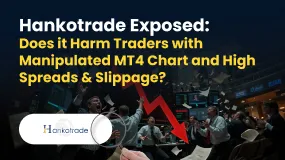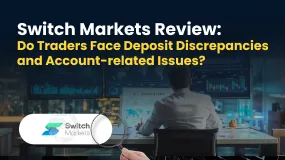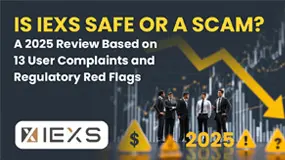简体中文
繁體中文
English
Pусский
日本語
ภาษาไทย
Tiếng Việt
Bahasa Indonesia
Español
हिन्दी
Filippiiniläinen
Français
Deutsch
Português
Türkçe
한국어
العربية
Deepfake Deception: New Face of Financial Scams in Forex and Crypto
Abstract:In the ever-evolving landscape of financial scams, fraudsters are now leveraging cutting-edge artificial intelligence (AI) to deceive unsuspecting victims. Deepfake technology, which manipulates audio and video to create hyper-realistic but entirely fabricated content, has become a powerful tool for scammers, particularly in the forex and cryptocurrency markets.

In the ever-evolving landscape of financial scams, fraudsters are now leveraging cutting-edge artificial intelligence (AI) to deceive unsuspecting victims. Deepfake technology, which manipulates audio and video to create hyper-realistic but entirely fabricated content, has become a powerful tool for scammers, particularly in the forex and cryptocurrency markets. These scams often involve impersonating well-known figures, creating fake endorsements, or even fabricating entire investment webinars to lure traders into fraudulent schemes.

Deepfake scams in the financial industry typically follow a well-crafted script. Scammers use AI-generated videos to impersonate reputable figures—such as CEOs of brokerage firms, famous traders, or financial analysts—to endorse fraudulent investment opportunities. These manipulated videos are often distributed through social media platforms, WhatsApp groups, or even directly via email campaigns.
One common tactic involves deepfake videos of financial influencers or industry leaders “promoting” a trading platform with promises of guaranteed high returns. Some fraudsters go as far as staging live video calls, where victims believe they are interacting with a real person, when in fact, it is an AI-generated deepfake controlled by the scammer. This level of deception adds a layer of credibility that traditional scams could never achieve, making it increasingly difficult for traders to differentiate reality from fiction.
Recognising deepfake scams requires vigilance and an understanding of the subtle inconsistencies that AI-generated content often exhibits. One of the most common red flags is unnatural facial movements. Deepfake videos may struggle to replicate natural eye movements, blinking patterns, or lip synchronisation when speaking. If something about the facial expressions or the way a person moves appears slightly off, it is worth investigating further.
The voice in a deepfake video can also provide clues. While AI-generated voices have improved significantly, they often lack natural intonations or may sound slightly robotic. In some cases, the tone may fluctuate awkwardly, or certain words may be pronounced in an unnatural way. Comparing the voice in a suspected deepfake with known recordings of the person can help reveal inconsistencies.
Another telltale sign is pixelation and blurring, especially around the edges of a persons face, which is common in AI-generated videos. These distortions become more apparent when the subject moves quickly or turns their head. If a video appears slightly off in quality, particularly in high-definition formats, it could indicate manipulation.
Deepfake scams often lure victims with offers that seem too good to be true. Any investment promising guaranteed profits with little to no risk should immediately raise red flags, regardless of how convincing the presenter appears. No legitimate financial institution can ensure risk-free returns, and any claim to the contrary is likely fraudulent.
Finally, verifying information from official sources is crucial. If a well-known figure is seemingly endorsing an investment opportunity, checking their official website or social media profiles can help confirm whether the endorsement is legitimate. Scammers frequently hijack the likeness of celebrities and financial experts without their knowledge, so relying on trusted sources for confirmation is essential.
To avoid falling victim to deepfake scams, always double-check identities before engaging with any financial offer. Conducting independent research on the company or individual making the claim can help uncover inconsistencies or past fraudulent activity. Official financial regulatory websites are useful sources for verifying whether a broker or investment platform is licensed.
It is also important to be wary of high-pressure tactics. Scammers often create a sense of urgency, urging victims to act quickly before an “exclusive opportunity” disappears. This strategy is designed to prevent critical thinking and force individuals into making impulsive decisions. Legitimate financial institutions do not rush investors into making commitments.
If a video or image seems suspicious, using reverse image and video search tools can help determine if it has been altered or used elsewhere. Scammers frequently recycle the same deepfake materials across multiple fraud schemes, so searching for prior instances of the same footage can expose the deception.
Strengthening online security is another crucial step. Enabling multi-factor authentication (MFA) on financial accounts adds an extra layer of protection against identity fraud. If scammers obtain personal details through deepfake scams, they may attempt to access victims' financial accounts, making additional security measures essential.
Before making any investment decision, consulting a licensed financial professional is always advisable. Relying on regulated experts rather than social media promotions or online videos ensures that investment choices are based on sound financial advice rather than fraudulent schemes.
As AI technology continues to advance, deepfake scams will only become more sophisticated. While governments and financial institutions are actively developing detection tools, awareness remains the strongest defence. By staying informed and scrutinising online financial offers carefully, traders can protect themselves from falling victim to these AI-driven frauds.
In an era where seeing is no longer believing, scepticism is no longer just an option—it is a necessity.

Disclaimer:
The views in this article only represent the author's personal views, and do not constitute investment advice on this platform. This platform does not guarantee the accuracy, completeness and timeliness of the information in the article, and will not be liable for any loss caused by the use of or reliance on the information in the article.
Read more

Hankotrade Exposed: Does it Harm Traders with Manipulated MT4 Chart and High Spreads & Slippage?
Have you witnessed a manipulated MT4 chart on Hankotrade login, showing inaccurate trading figures? Have you been victimized by high swap fees, inflated spreads, and massive slippage? Is the payment processing time too long at Hankotrade? Do you face downtime issues, especially when the New York trading session is on? These are some top complaints against the Belize-based forex broker. In this article, we have shared these complaints. Take a look!

Switch Markets Review: Do Traders Face Deposit Discrepancies and Account-related Issues?
Do you fail to deposit your funds into the Switch Markets forex trading account? Earned profits, withdrew them too, but did Switch Markets block your deposits? Wanted to close your trading account due to payment-related issues, but in turn got your emails blocked by the Australia-based forex broker? Faced a negative trading account balance because of illegitimate trade order execution? Many traders have shared these stories about Switch Markets on broker review platforms. In this Switch Markets review article, we have mentioned the same. Read on!

Is IEXS Safe or a Scam? A 2025 Review Based on 13 User Complaints and Regulatory Red Flags
You're asking a direct and important question: Is IEXS safe or a scam? As someone who might trade with them or already does, this is the most important research you can do. While IEXS says it is a global broker with over ten years of experience, a detailed look at its regulatory status and many user reviews shows serious warning signs that cannot be ignored. The evidence suggests a high-risk situation for traders' capital. This review will examine the available information, from official regulatory warnings to concerning first-hand user complaints, to give you a clear and fact-based view of the risks involved in trading with IEXS. Our goal is to give you the facts you need to make a smart decision.

Having Trouble Getting Your Funds Out of IEXS? A Simple Guide to Delays and Solutions
Are you having trouble withdrawing funds from your IEXS account or facing delays getting your funds? Not being able to access your own capital is one of the most stressful situations any trader can face. It breaks down your basic trust with a broker. This isn't just annoying - it's a serious problem that can mess up your financial plans and cause a lot of worry. This guide goes beyond basic advice. We'll look at real user experiences and official regulatory information to give you clear answers. Our goal is to help you understand why IEXS withdrawal problems happen and show you practical steps you can take. We understand your concerns and want to give you the information you need to handle this tough situation.
WikiFX Broker
Latest News
150 Years Of Data Destroy Democrat Dogma On Tariffs: Fed Study Finds They Lower, Not Raise, Inflation
FIBO Group Ltd Review 2025: Find out whether FIBO Group Is Legit or Scam?
Is INGOT Brokers Safe or Scam? Critical 2025 Safety Review & Red Flags
Trillium Financial Broker Exposed: Top Reasons Why Traders are Losing Trust Here
Amillex Withdrawal Problems
IEXS Review 2025: A Complete Expert Analysis
IEXS Regulation: A Complete Guide to Its Licenses and Safety Warnings
Oil and gas giant Wood plc sold to Dubai engineering firm
FONDEX Review: Do Traders Really Face Inflated Spreads & Withdrawal Issues?
【WikiEXPO Global Expert Interviews】Ashish Kumar Singh: Building a Responsible and Interoperable Web3
Currency Calculator



